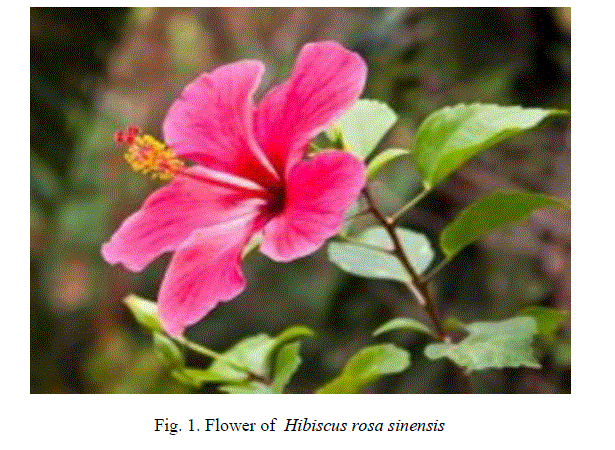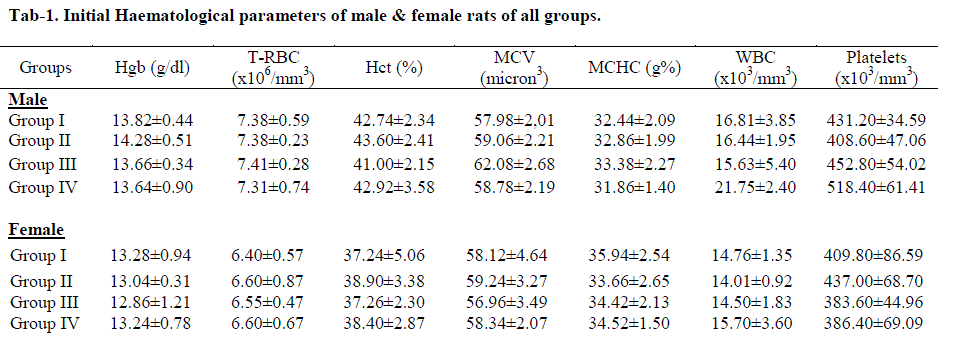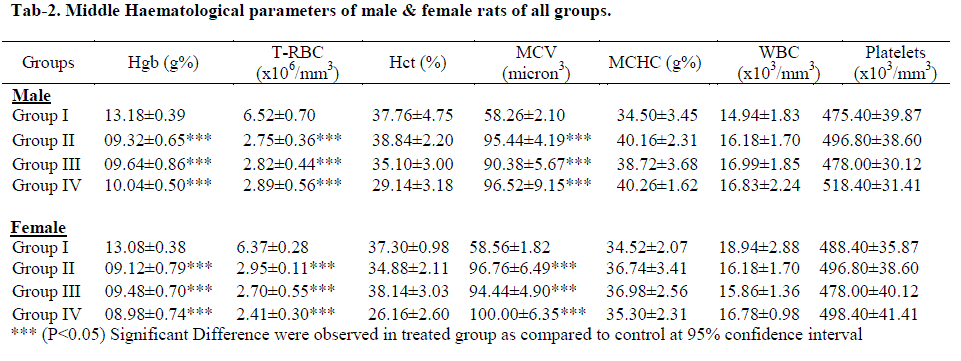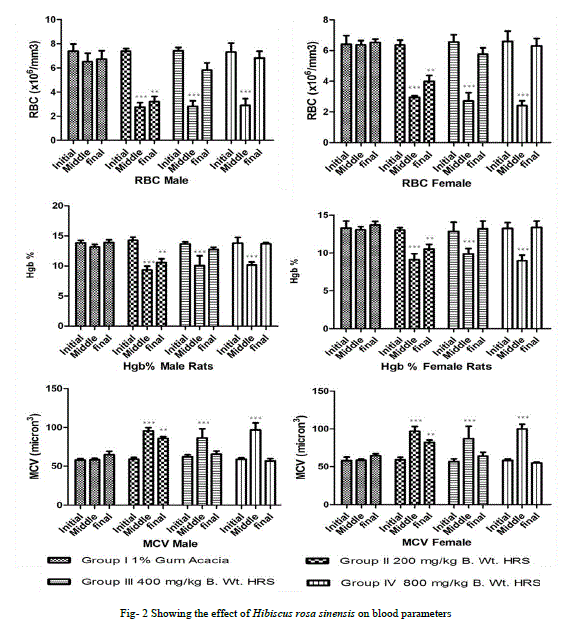ISSN ONLINE(2319-8753)PRINT(2347-6710)
ISSN ONLINE(2319-8753)PRINT(2347-6710)
Anil Kumar Meena1, Devendra Patidar2 and R. K. Singh1*
|
| Related article at Pubmed, Scholar Google |
Visit for more related articles at International Journal of Innovative Research in Science, Engineering and Technology
This research work was focused on the haemoprotective activity of methanolic extract of Hibiscus rosa sinensis L. (HRS) flowers against phenylhydrazine induced haematotoxicity in Charles foster rats. Haemoprotective activity of methanolic extract of HRS flowers were estimated by using haematological parameter of Charles foster rats and it was evaluated with the help of MS9 fully automated haematology analyzer. The experimental activities for the methanolic extract of HRS exhibited statistically significant (p<0.005) haemoprotective activity against phenylhydrazine induced haematotoxicity in Charles foster rats. In conclusion, these observations provide evidence and possible mechanism of action for the haemoprotective activity of methanolic extract of HRS flowers. This activity of extract may be due to high phenolic and flavonoid contents.
Keywords |
| Haemoprotective, Hibiscus rosa sinensis, Free Radical, Scavenging, Phenylhydrazine, Hemolytic anemia. |
INTRODUCTION |
| The Hibiscus rosa sinensis (Fam. Malvaceae) is a glabrous shrub available throughout India and widely cultivated in the tropics as an ornamental plant and has several forms with varying colours of flowers. It is native to china and also occurs in India and Philippines. The leaves, flowers and roots of the plant were found to have many medicinal values. In medicine however the red flowers varieties was preferred. Several articles and ancient literature have shown that the flowers of this plant possess anti-infertility activity1, Antispermatogenic and Androgenic activity2, Anti-tumour3, Antiimplantation 4, Antidiabetic5, Antioxidant activity6 and Anti-depressant activity7. The objective of the present study was to investigate the Haemoprotective activity of the methanolic extract of the flowers of HRS. Phenylhydrazine is yellow to pale brown crystals or as a yellowish oily liquid, with a freezing point of 19.6°C and boiling point of 243.4°C. For many years phenylhydrazine was used for experimental induction of anaemia in animals. Phenylhydrazine induces the destruction of red blood cells by oxidative stress and many joint changes at cellular level resulting haemolytic anemia, it also decreases hemoglobin level, red blood cell concentration and packed cell volume, and impairs erythrocyte deformability8. |
II. MATERIALS AND METHODS. |
Plant material |
| The fresh flowers of Hibiscus rosa sinensis (Fam. Malvaceae) were collected from a local commercial source in Lucknow (India). This plant was identified by the Division of Botany, CSIR-Central Drug Research Institute Lucknow. Paper is organized as follows. Section II describes automatic text detection using morphological operations, connected component analysis and set of selection or rejection criteria. The flow diagram represents the step of the algorithm. |
| After detection of text, how text region is filled using an Inpainting technique that is given in Section III. Section IV presents experimental results showing results of images tested. Finally, Section V presents conclusion. |
 |
Preparation of plant extract |
| The flowers were dried at room temperature and grind in to powder form. This dried powder (2kg) was macerated in 100% Methanol and kept for 48 h at room temperature. The resulting extract was filtered with the help of whatman filter paper and this filtrate was concentrated in hot air oven at 40oc for 24 hrs at constant weight giving an 8.5% yield (w/w) of crude powders. The extract was stored at room temperature. |
Experimental animals |
| Charles Foster rats (150-175 gm) of both sexes were obtained from National Laboratory Animal Center (NLAC), Central Drug Research Institute, Lucknow (India) and were allowed to acclimatize for 7 days prior to experimentation. The animals maintained under standard laboratory conditions (25±2oC and 30–60% relative humidity with a 12 h light and dark cycle). The animals were feed with standard rodent pellet diet and water ad libitum. Animal studies were conducted according to the regulations of the Institute Animal Ethics Committee and the protocol was approved by the Committee for the Purpose of Control and Supervision of Experiments on Animals, New Delhi (India), IAEC No.- IAEC/2012/86. |
Experimental Design |
| A total number of 40 rats (20 males and 20 females) were divided into 4 groups. Each group contained 5 male and 5 female rats kept in different cages. Group I served as control received only distilled water, Group II, III, IV rats were administered phenylhydrazine at a dose of 10 mg/kg of body weight for seven consecutive days for the induction of Anemia, After seven Days the rat of Group II were received 200 mg/kg HRS extract, Group III rats were received 400 mg/kg HRS extract and Group IV rats received 800 mg/kg HRS. All the doses were administered orally by gavage for 7 days. |
| mask image and then find boundary of target region. For all the boundary points it defined patch and find the priority of these patches. It starts filling the target region from the highest priority patch by finding the best match patch. This procedure is repeated until entire target region is inpainted. The algorithm automatically generates mask image without user interaction that contains only text regions to be inpainted. |
Food and water consumption |
| Monitoring 24-hour food and water consumption of the animals in a group was done at the beginning, middle and end of the study by giving a measured quantity of water and pellet diet followed by estimation of the amounts remaining at the end of 24 hours. Average food and water consumption per animal was calculated for each group. |
Assessment of haemoprotective Activity |
| Blood samples were collected at 0 and 7th and 14th day through tail vein in EDTA coated vials. Hematological parameters were analysed by using MS-9 fully automated hematology analyzer. The following parameters were determined like Erythrocyte (RBC), total and differential leukocyte (WBC), hematocrit (Hct), hemoglobin (Hb), platelet count(Plt.), mean corpuscular volume (MCV), mean corpuscular hemoglobin concentration (MCHC). |
Absolute and relative organ weight |
| At the end of the study (14days), all organs were collected using standardized surgical procedures. The abdominal cavity of each animal was dissected and organs mainly heart, liver, lungs, spleen, kidney and brain were quickly removed, cleaned with normal saline, weighed and preserved in 10% formalin. |
Statistical analysis |
| All the results were expressed as mean ± standard deviation (S.D.). Data was analyzed using one-way ANOVA (Graph Pad Prism Software) at 95% confidence interval. |
| All the results were expressed as mean ± standard deviation (S.D.). Data was analyzed using one-way ANOVA (Graph Pad Prism Software) at 95% confidence interval. |
III. RESULTS |
Food and water consumption |
| The rats treated with PHZ at dose of 10 mg/kg(7days) showing decrease in the consumption of food and water as compare to control group but not significant. There is no significant difference were seen in the food water consumption of animals of different treatment groups treated with HRS at dose 200, 400, 800 mg/kg b. wt. |
| Hemoprotective Activity Haematological parameter was observed on 0, 7th, and 14th day of the study period. After 7 days phenylhydrazine dosing, all groups except control showed a significant (p<0.05) decrease in RBC, Hgb and increase in MCV level. After 7 days group II, III, IV were treated with 200, 400 and 800mg/kg HRS plant extract respectively for next 7 days. The haematological parameter observed on day 14th, showed a significant (p<0.05) normalization of the haematological parameter in group III and IV but not in Group II. In other haematological parameter no significant difference were observed in treated groups as compare to control group. Absolute and relative organ weight The rats treated with PHZ at 10 mg/kg showing Splenomegaly (Data Not Showed), there were significant increase in the weight of spleen as compare to control group. No significant effect was shown in the weight of other organs as compare to control. The increased spleen weight is 100% Recovered by HRS flower extract. |
 |
 |
 |
 |
IV. DISCUSSION |
| Exposure to phenylhydrazine may cause damage to red blood cells, potentially resulting in anaemia and consequentially secondary involvement of other tissues, such as the spleen and liver9. Phenylhydrazine induces the destruction of red blood cells by oxidation stress and many joint changes at cellular levels resulting in haemolytic anaemia. PHZ-induced toxic anaemia offers a model for research of haemolytic anaemia and the influence of anaemia on other physiological processes. Phenylhydrazine causes toxicity by the involvement of aryl and hydroxyl radical. Pharmacological investigations of the genus Hibiscus have demonstrated interesting biological activities. In this study, a methanolic extract of HRS flowers was studied to determine its haemoprotective activity. The possible haemoprotective effect of HRS may be explained by the presence of Phenolics, flavonoids, alkaloids, saponins and steroids, which were identified in the samples. It is already published that all the above secondary metabolites have good antioxidant activity6. The present study provides excellent evidence for the haemoprotective activities of HRS. |
V. CONCLUSION |
| Our study indicate that HRS flowers has showed remarkable haemoprotective activity because the plant extract contain high phenolic flavonoid and alkaloid contents. 400mg/kg and 800mg/kg plant extract completely normalize haematotoxicity induced by phenylhydrazine as compare to control. 200mg/kg plant extract does not show significant protection. |
References |
|